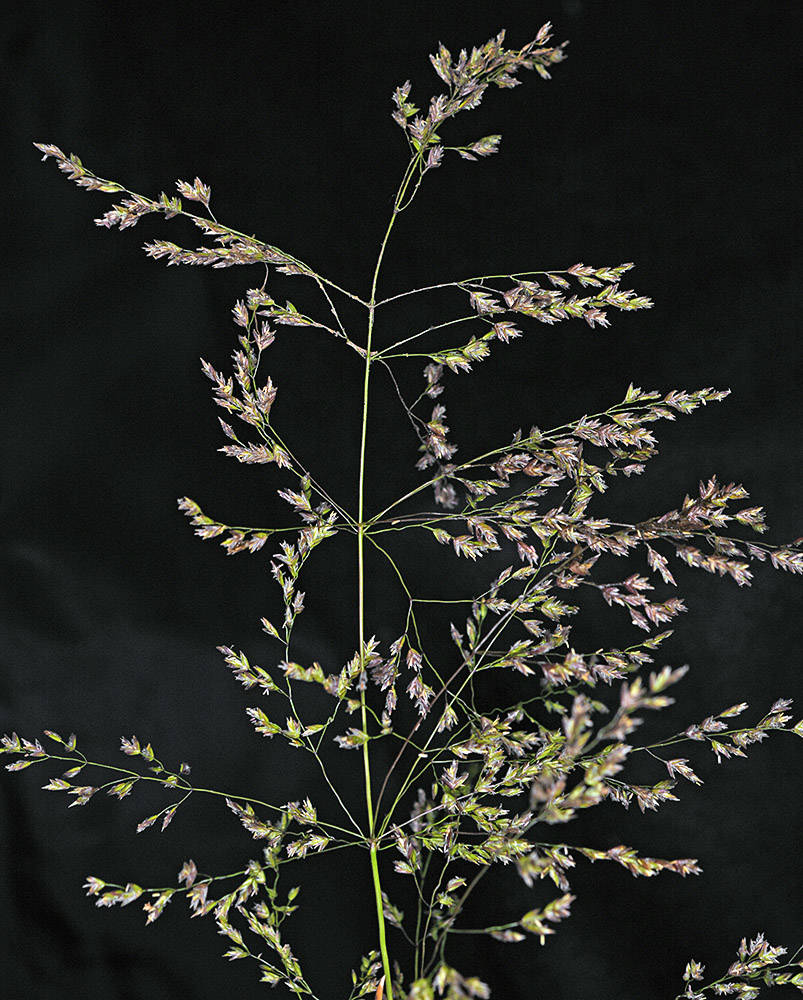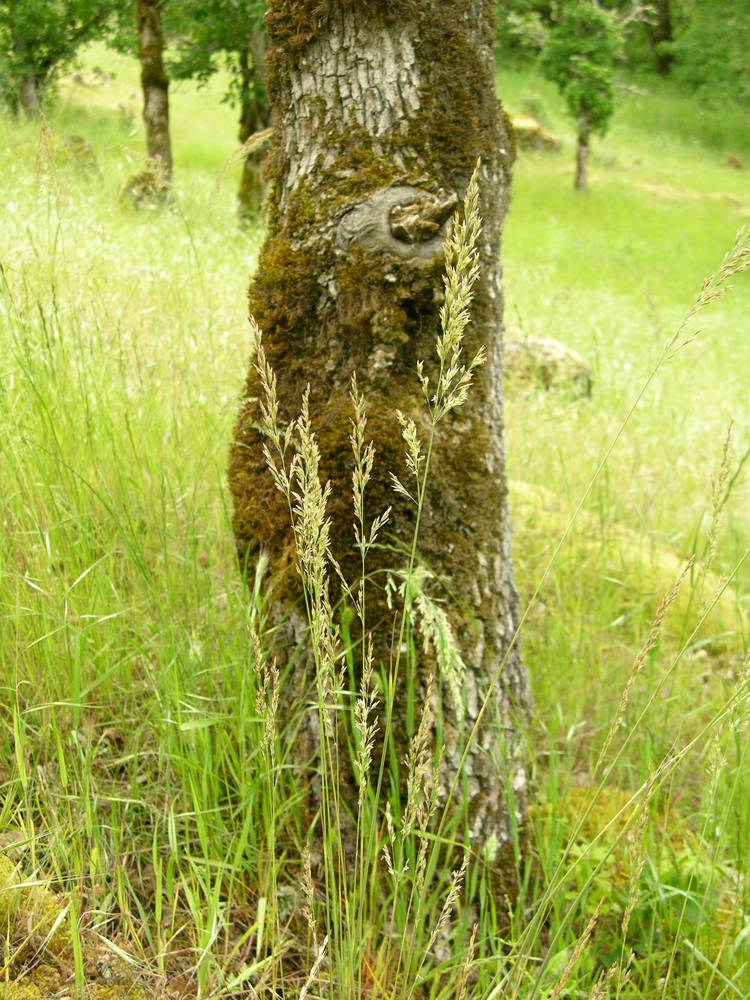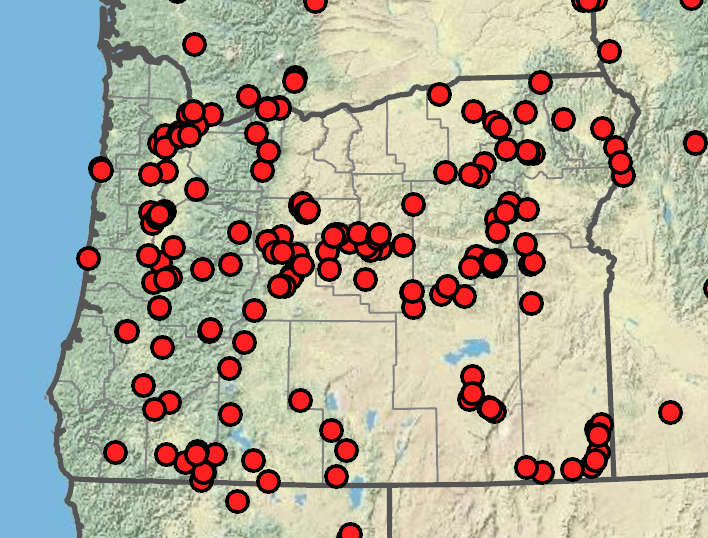Poa palustris
Poa secunda
fowl bluegrass
secund bluegrass
nodes terete to slightly compressed;
proximal nodes often slightly swollen; the uppermost node usually at or above the middle of the culm.
slender to stout;
nodes terete, 0–2 exserted.
extra- and intravaginal.
intra- and extravaginal.
sheaths closed to 20% of their length, bases of basal sheaths glabrous;
ligules (1)1.5– 6 mm, truncate to acute;
blades flat, 1.5–8 mm wide, usually several on the culm, steeply ascending or spreading to 80°; upper blades often lax.
sheaths closed to 25% of their length, bases of basal sheaths glabrous;
collars smooth or scabrous, glabrous;
ligules 0.5–6(10)mm;
blades flat, folded, or involute, 0.4–3(5) mm wide, green to strongly glaucous; thin; soft and soon withering, or thick; firm and persisting; smooth, or scabrous mainly over the veins;
blades gradually reduced distally or the middle blades longest; uppermost blades 0.8–10(17)cm.
lax, eventually open, sparsely to moderately congested; (9)13–30(41)cm, generally 33–50% as broad as long at maturity;
spikelets 25–100+;
branches initially erect, eventually widely spreading to slightly reflexed, fairly straight; slender, 4–15 cm, 33–50% of the panicle length, 2–9 per node.
erect or somewhat lax, narrowly lanceoloid to ovoid, usually contracted; more or less open in flower, infrequently remaining open at maturity, usually moderately congested, 2–25(30) cm;
spikelets 10–100+;
branches usually erect or ascending, infrequently spreading at maturity; (0.5)1–8(10) cm, 1–3 per node, with (1)2–20(60+) spikelets in distal 50–67%.
narrowly to broadly lanceolate, 3–3.5 times as long as wide, 3–5 mm;
florets (1)2–5;
rachilla internodes mostly less than 1 mm.
usually narrowly lanceolate; more or less terete to slightly laterally compressed; (3.8)4–5 times as long as wide; (4)5–10 mm;
florets (2)3–5(10);
rachilla internodes usually 1–2 mm long; smooth to scabrous.
tapering from the base or lanceolate, distinctly keeled;
keels smooth or sparsely scabrous;
lower glumes 3-veined; long tapered to a slender point, 6.4–10 times as long as wide.
broadly lanceolate;
keels indistinct;
lower glumes 3-veined.
glabrous, or with a line of crisp or slightly sinuous hairs 0.1–0.5(2) mm long around the base.
lanceolate to narrowly lanceolate or slightly oblanceolate, 3.5–6 mm, usually weakly keeled, glabrous throughout or keels and marginal veins softly puberulent to short-villous; area between veins smooth or scabrous, glabrous; short-villous, crisply puberulent, or loosely softly puberulent over the basal 67%;
hairs usually 0.1–0.5 mm long;
margins strongly inrolled below, broadly scarious above, glabrous;
tips obtuse to broadly acute; blunt or pointed.
1.5–3 mm.
Poa palustris
Poa secunda
Moist meadows, shorelines, ditches, forests, disturbed areas. 0–2600m. BR, BW, Casc, Col, ECas, Lava, Owy, WV. CA, ID, NV, WA; throughout most of Canada and US; circumboreal. Exotic?
Poa palustris has an open inflorescence, small lemmas and an open growth form produced by culms that often branch above the base. Poa nemoralis differs in having short, truncate ligules. Poa palustris from drier sites can be similar to P. interior, which has more lax leaf blades, calluses with sparse, short hairs, wider hyaline lemma margins and straight to slightly curved lemma keels. Poa interior has not been documented in Oregon. Both native and introduced populations of Poa palustris exist in North America, and Oregon plants have generally be considered introduced. However, some populations may be native.
2 subspecies.
Poa secunda is a common, highly variable, densely cespitose grass mainly of uplands. The spikelets are terete to slightly compressed, and the lemmas are more or less rounded over the back and usually hairy to scabrous throughout. Poa stenantha can be very similar, but its lemmas are a bit more strongly keeled and have hairs only on the veins. Callus hairs, if present, are 0.2–2 mm long. Hybrids between P. secunda and P. pratensis (P. × limosa) occur in moist, alkaline meadows in southeastern Oregon. They resemble P. secunda but are more or less rhizomatous and may have more strongly keeled lemmas. Hybrids with P. nervosa, called P. × multnomae, occur in the Columbia Gorge. They have more open panicles and generally grow in moister habitats than P. secunda. Puccinellia lemmonii and Poa secunda are superficially similar, but Puccinellia lemmonii has lower glumes that are less than 50% as long as the lowest lemma, and it grows in more strongly alkaline meadows and flats that are generally wet in spring. Poa secunda is a highly variable taxon. Its combination of asexual and sexual seed production produces multiple widespread, morphologically consistent forms that are sympatric. Many of these variants have been treated as species. However, intermediates can be found between all of them. Here we gather these forms into two categories treated as subspecies.
Rob Soreng, Barbara Wilson, Richard Brainerd, Nick Otting
Rob Soreng, Barbara Wilson, Richard Brainerd, Nick Otting
- Local floras:
BC,
CA,
OR,
WA
- Local Web sites:
CalFlora,
CalPhotos,
Flora NW,
PNW Herbaria
WildflowerSearch
iNaturalist (observations)
USDA Plants Database
- LBJ Wildflower Center
- SEINet
- Plants of the World Online
- Encyclopedia of Life
- Wikipedia
- Google Image Search
- Local floras:
BC,
CA,
OR,
WA
- Local Web sites:
CalFlora,
CalPhotos,
Flora NW,
PNW Herbaria
WildflowerSearch
iNaturalist (observations)
USDA Plants Database
- LBJ Wildflower Center
- SEINet
- Plants of the World Online
- Encyclopedia of Life
- Wikipedia
- Google Image Search





